

Dr. Jeffrey L Beck
Dept of Ecosystem Science and Management
Agriculture Building 2004
Department #3354
1000 E. University Ave
Laramie, WY 82071
Phone: (307) 766-6683
Fax: (307) 766-6403
Email: jlbeck@uwyo.edu

MS Student: Adele Reinking
News Articles
Energy infrastructure across North America continues to increase as growing importance is placed on domestic production. Impacts of such development have the potential to affect wildlife by altering movement patterns, habitat selection, behavior, and demography (Sawyer et al., 2005; Beckmann et al., 2012), and have increasingly become the focus of management and conservation efforts. Wyoming has seen some of the greatest increases in resource extraction, with several of the largest energy fields in the country occurring there. According to the Wyoming Bureau of Land Management (BLM), the state is first in both coal production and onshore oil and gas production nation-wide (2012). Many of the areas that are ideal for energy infrastructure also comprise preferred habitat for native wildlife species. Pronghorn (Antilocapra americana) is one such animal that is endemic to North America. This ungulate inhabits expansive, relatively flat areas of grassland and sagebrush (Artemisia spp.) steppe, and is the only extant species of the Antilocapridae family. Wyoming is home to greater than 50% of the entire pronghorn population (Yoakum and O’Gara 2000, Beckman et al., 2012), making research of the animals in the state crucial for our understanding of the species.
Our study is designed to evaluate productivity, resource selection, and response to anthropogenic disturbance for adult female pronghorn influenced by oil and gas development in the Red Desert of south-central, Wyoming. Pronghorn have been declining across much of the Red Desert—an iconic region for pronghorn and one of the most sought-after licenses for pronghorn hunting. Pronghorn inhabiting the Wyoming Game and Fish Department Baggs and Bitter Creek Herd Units are under increasing pressure from changing environmental conditions and expanding energy development, and have failed to recover from population declines over the past 20 years. To evaluate the additive influences of environmental change and expanding energy infrastructure on pronghorn in these two study areas, we will compare resource selection and demographic responses of roughly 90 does (fitted with VHF or store-on-board GPS collars) to those of 44 collared pronghorn in the northern portion of the Red Desert, where energy development is minimal. With this research, we intend to address the following three objectives:
To meet each of these objectives, we have outlined methods for our capture events
and subsequent monitoring. In November of 2013, 130 adult females were captured using
helicopter net guns. Each doe was weighed and aged, and samples were taken for disease,
stress, and pregnancy testing. Additionally, body condition was assessed with palpation
and fat measurements taken with ultrasonography. Each animal was also fitted with
a VHF or GPS collar prior to release. Our sample size of 130 adult females will be
maintained over the course of the study through multiple capture events. During each
summer season, we plan to monitor the behavior of collared pronghorn through instantaneous
scan sampling. We will also quantify adult female-to-fawn ratios both through aerial
and ground observations. Finally, we will evaluate the influence of roads on pronghorn
resource selection by measuring vehicle traffic volumes year-round using infrared
monitors. Our study will incorporate the use of telemetry data in conjunction with
resource use and demographic modeling to ascertain the additive and potentially interactive
effects of changing climate and increased energy development on population performance
of pronghorn.
With this research, we hope to determine which factors influence pronghorn demography and resource selection in the Red Desert. Ideally, this information will help in improving management of the animals in the Red Desert, and across the state of Wyoming. Additionally, we hope that this work will increase knowledge of pronghorn habitat selection in the face of energy development, which is greatly understudied (Hebblewhite 2008). While our project has the potential to advance knowledge on the effects of environmental and anthropogenic influences on local and national populations of American pronghorn, it also has the potential to benefit understanding of other ungulate species or even animals outside of this taxon. As energy development is increasing throughout North America and worldwide, our ability to assess the effects of resource extraction on wildlife will be critical to guide mitigation and successful management.
Literature Cited
Beckmann, J. P., Murray, K., Seidler, R. G., and J. Berger. 2012. Human-mediated shifts in animal habitat use: Sequential changes in pronghorn use of a natural gas field in Greater Yellowstone. Biological Conservation 147:222-233.
Bureau of Land Management [BLM]. 2012. Energy Development on BLM Lands: 13th Annual Energy Exposition and Symposium. U.S. Department of the Interior Bureau of Land Management Wyoming State Office, Cheyenne, Wyoming, USA.
Hebblewhite, M. 2008. A literature review of the effects of energy development on ungulates: Implications for central and eastern Montana. Report prepared for Montana Fish, Wildlife and Parks, Miles City, Montana, USA.
Sawyer, H., Lindzey, F. and D. McWhirter. 2005. Mule deer and pronghorn migration in western Wyoming. Wildlife Society Bulletin 33:1266-1273.
Yoakum, J. D., and B. W. O’Gara. 2000. Pronghorn. Pages 559–577 in S. Demarais, and P. R. Krausman, editors. Ecology and Management of Large Mammals in North America. Prentice Hall, Upper Saddle River, New Jersey, USA.
Dr. Jeffrey L Beck
Dept of Ecosystem Science and Management
Agriculture Building 2004
Department #3354
1000 E. University Ave
Laramie, WY 82071
Phone: (307) 766-6683
Fax: (307) 766-6403
Email: jlbeck@uwyo.edu